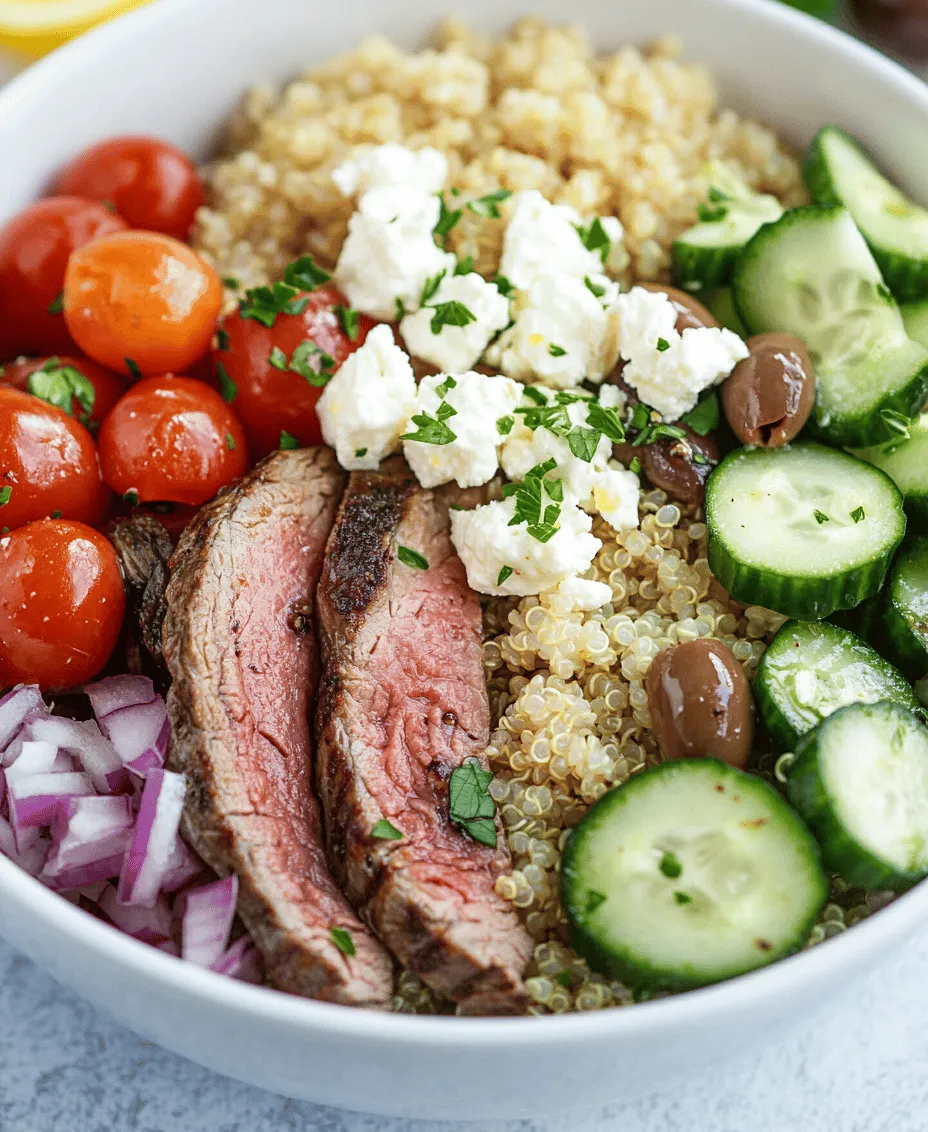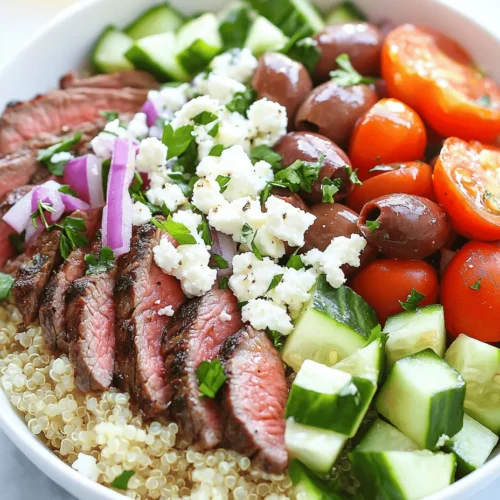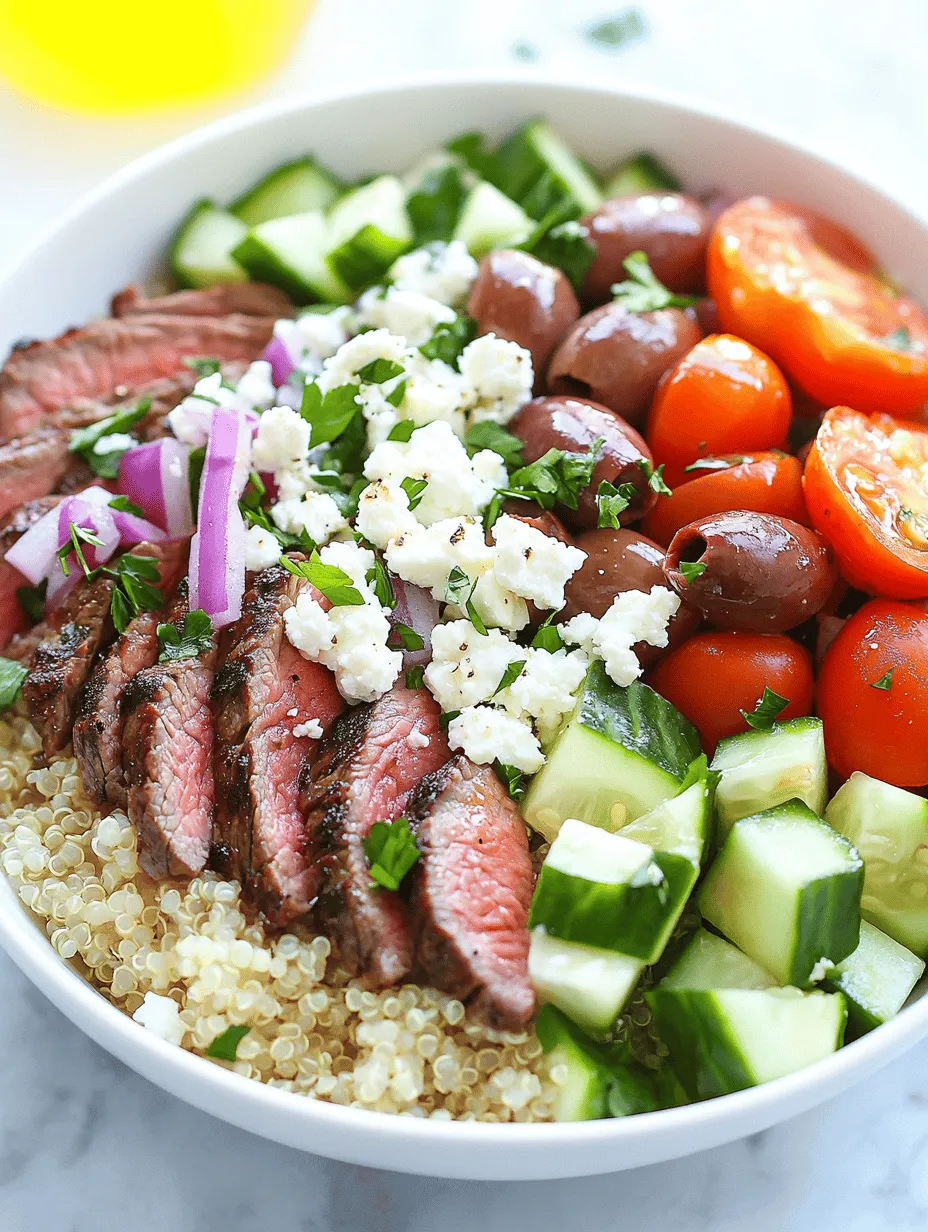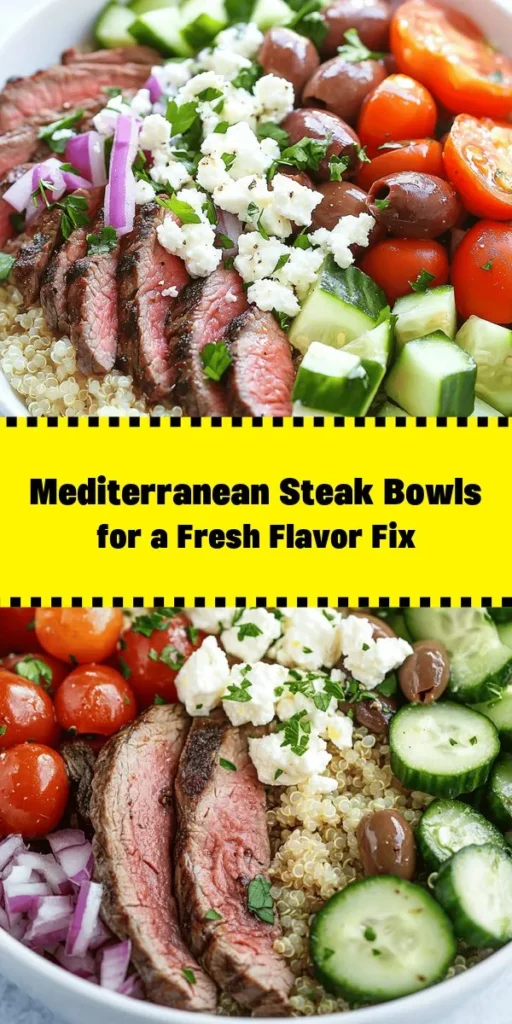Introduction
The Mediterranean diet has long been celebrated not only for its delicious flavors but also for its numerous health benefits. This eating pattern emphasizes whole foods, healthy fats, lean proteins, and plenty of fresh fruits and vegetables. Studies have shown that adhering to a Mediterranean-style diet can reduce the risk of chronic diseases, improve heart health, and even support weight management. With an emphasis on vibrant, nutrient-rich ingredients, it’s no wonder that people are increasingly turning to Mediterranean-inspired meals to nourish their bodies.
One such meal that embodies the essence of the Mediterranean diet is the Mediterranean Steak Bowl. This dish is a harmonious blend of flavors and textures, featuring perfectly marinated flank steak, fluffy quinoa, and a colorful array of fresh vegetables. Topped with tangy feta cheese and briny Kalamata olives, every bite is a delightful explosion of taste. Whether you’re looking for a satisfying weeknight dinner or a meal prep option for healthy lunches, these steak bowls are versatile and easy to customize to suit your palate.
In this article, we will explore the essential components of Mediterranean Steak Bowls, focusing on the key ingredients that make this dish not only delicious but also nutritious. We will dive into the importance of marinating the steak for maximum flavor and provide detailed instructions on how to cook quinoa to perfection. By the end, you’ll be well on your way to creating a dish that is not only good for you but also bursting with Mediterranean flair.
Understanding the Ingredients
To create the perfect Mediterranean Steak Bowl, it’s crucial to understand the ingredients that come together to form this flavorful dish. Each component plays a vital role in contributing to the overall taste and nutritional value.
Flank Steak: Nutritional Benefits and Flavor Profile
At the heart of the Mediterranean Steak Bowl is flank steak, a cut of beef known for its rich flavor and tenderness when properly cooked. Flank steak is a lean cut, making it a healthier choice compared to fattier beef cuts. It’s also a great source of high-quality protein, essential for muscle repair and growth. Additionally, flank steak contains important nutrients such as iron and zinc, which support immune function and energy production.
To make the most of this ingredient, it’s important to cook it correctly. Flank steak should be grilled or seared quickly at high heat to retain its juiciness and flavor. The cut’s natural grain should be sliced against the grain to ensure tenderness in every bite. When seasoned and marinated properly, flank steak can be the star of your Mediterranean Steak Bowl, providing a savory foundation for the other fresh ingredients.
Quinoa: A Superfood Packed with Protein and Fiber
Quinoa has gained popularity as a superfood in recent years, and for good reason. This gluten-free grain is not only nutritious but also incredibly versatile. Quinoa is a complete protein, containing all nine essential amino acids, making it an excellent choice for vegetarians and meat-eaters alike. Additionally, it is rich in fiber, which aids in digestion and promotes a feeling of fullness.
When cooked, quinoa has a light, fluffy texture and a mild, nutty flavor that pairs beautifully with the other components of the Mediterranean Steak Bowl. It serves as a wholesome base for the dish, providing not just sustenance but also valuable nutrients that complement the protein from the steak.
Fresh Vegetables: Importance of Incorporating Colorful Produce
No Mediterranean dish would be complete without a vibrant array of fresh vegetables. In Mediterranean Steak Bowls, you can add a variety of colorful produce to enhance both the flavor and nutritional profile of your meal. Consider incorporating bell peppers, cucumbers, cherry tomatoes, red onions, and leafy greens such as arugula or spinach.
These vegetables are packed with vitamins, minerals, and antioxidants that contribute to overall health. They add not only color and crunch but also a refreshing contrast to the savory steak and hearty quinoa. Plus, the more colors you include, the more nutrients you’ll get, making your meal even more beneficial.
Feta Cheese and Kalamata Olives: Traditional Mediterranean Flavors
To truly capture the essence of the Mediterranean, you cannot overlook the importance of feta cheese and Kalamata olives. Feta is a tangy, crumbly cheese that adds creaminess and depth to the dish. It is lower in fat compared to many other cheeses, making it a lighter option that still packs a flavor punch.
Kalamata olives, with their distinct briny and slightly bitter taste, provide an authentic Mediterranean flair. They are rich in healthy fats, particularly monounsaturated fats, which are known to support heart health. The combination of feta and olives not only elevates the flavor profile of the Mediterranean Steak Bowl but also enhances its nutritional value.
Marinating the Steak
Marination is a key step in preparing flank steak for your Mediterranean Steak Bowl. It enhances the flavor of the meat, making it tender and juicy. A good marinade will infuse the steak with aromatic herbs and spices, ensuring that every bite is packed with flavor.
Importance of Marination in Enhancing Flavor
When you marinate steak, the acid in the marinade helps to break down the proteins in the meat, making it more tender. Additionally, the flavors from the marinade penetrate the meat, resulting in a more flavorful dish. For Mediterranean Steak Bowls, a marinade that includes olive oil, lemon juice, garlic, and a selection of fresh herbs will complement the other ingredients beautifully.
Step-by-Step Instructions on How to Prepare the Marinade
Creating a delicious marinade for your flank steak is simple and quick. Here’s a step-by-step guide:
1. Gather Your Ingredients: For the marinade, you will need:
– 1/4 cup olive oil
– 1/4 cup lemon juice (freshly squeezed is best)
– 3 cloves of garlic, minced
– 1 teaspoon dried oregano
– 1 teaspoon dried thyme
– Salt and pepper to taste
2. Mix the Marinade: In a bowl, combine the olive oil, lemon juice, minced garlic, oregano, thyme, salt, and pepper. Whisk until well combined.
3. Prepare the Steak: Place the flank steak in a resealable plastic bag or a shallow dish. Pour the marinade over the steak, ensuring it is well coated. Seal the bag or cover the dish with plastic wrap.
4. Marinate: For optimal flavor absorption, let the steak marinate in the refrigerator for at least 30 minutes, but ideally for 2 to 4 hours. If you have more time, marinating overnight will yield even better results.
Tips on Marinating Time for Optimal Flavor Absorption
– Don’t Over-Marinate: While marinating is beneficial, be cautious not to marinate for too long, especially with acidic ingredients like lemon juice. Over-marination can lead to a mushy texture.
– Room Temperature: Before cooking, allow the marinated steak to sit at room temperature for about 15-20 minutes. This helps it cook more evenly.
– Reserve Some Marinade: If you’d like to use the marinade as a sauce, set aside a portion before adding it to the raw meat. Always avoid mixing raw meat with reserved marinade to prevent contamination.
Cooking the Quinoa
Quinoa is a fantastic choice for a healthy grain alternative in your Mediterranean Steak Bowl. Cooking it properly is essential to achieve the perfect texture and flavor.
Explanation of Quinoa as a Healthy Grain Alternative
Unlike many grains, quinoa is not just a carbohydrate source; it is a complete protein, which means it contains all the essential amino acids. It is also gluten-free, making it suitable for those with gluten sensitivities. Additionally, quinoa is high in fiber, vitamins, and minerals, making it a nutrient-dense option that adds substantial health benefits to your meal.
Detailed Instructions on How to Cook Quinoa Perfectly
Cooking quinoa is straightforward, and following these steps will ensure you achieve fluffy, perfectly cooked grains:
1. Rinse the Quinoa: Start by rinsing 1 cup of quinoa under cold water in a fine-mesh strainer. This removes the saponins, a natural coating that can impart a bitter taste.
2. Measure the Liquid: In a medium saucepan, combine the rinsed quinoa with 2 cups of water or vegetable broth. Using broth will enhance the flavor of the quinoa.
3. Bring to a Boil: Place the saucepan over medium-high heat and bring the liquid to a boil.
4. Simmer: Once boiling, reduce the heat to low, cover the saucepan, and let it simmer for about 15 minutes. Do not lift the lid during cooking, as this can disrupt the steaming process.
5. Fluff and Rest: After 15 minutes, remove the saucepan from heat and let it sit, covered, for an additional 5 minutes. Then, uncover and fluff the quinoa with a fork.
Discussing the Benefits of Using Vegetable Broth vs. Water
Using vegetable broth instead of water to cook quinoa adds an extra layer of flavor to the dish. The broth infuses the grains with savory taste, making them more enjoyable and complementary to the other ingredients in your Mediterranean Steak Bowl. Additionally, vegetable broth often contains added nutrients and minerals, further enhancing the nutritional profile of the meal.
Now that you have a good understanding of the ingredients and initial steps involved in creating your Mediterranean Steak Bowls, you’re well on your way to preparing a delicious and wholesome meal that embodies the rich and vibrant flavors of the Mediterranean. In the next part of this article, we will delve into assembling the steak bowls and tips for serving to ensure your dish is as visually appealing as it is tasty.

Grilling the Flank Steak
To achieve the perfect doneness for your flank steak, understanding the nuances of grilling is essential. Flank steak is best cooked over high heat to sear the outside while keeping the inside tender and juicy. Here are some techniques to consider:
1. Preheat Your Grill: Ensure your grill is preheated to high heat (around 450°F to 500°F) before placing the steak on it. This temperature is crucial for achieving a nice sear.
2. Oil the Grill Grates: Prevent sticking by oiling your grill grates. You can do this by dipping a paper towel in vegetable oil and using tongs to wipe the grill grates.
3. Searing and Cooking Time: Place the flank steak on the grill diagonally to the grates. Grill for about 4-5 minutes on each side for medium-rare. Use a meat thermometer to check the internal temperature; aim for 130°F to 135°F for medium-rare. If you prefer your steak cooked more, add a couple of minutes per side, but be cautious not to overcook it, as flank steak can become tough.
4. Using a Skillet: If you don’t have access to a grill, a skillet can serve as an excellent alternative. Use a cast-iron skillet for best results. Heat the skillet over high heat, add a little oil, and follow the same grilling times. For added flavor, consider adding garlic or herbs to the skillet.
5. Resting the Steak: Once cooked to your desired doneness, remove the steak from the grill or skillet and let it rest for at least 5-10 minutes. Resting is crucial as it allows the juices to redistribute throughout the meat, ensuring every bite is flavorful and moist. After resting, slice against the grain to maintain tenderness.
Preparing the Mediterranean Vegetable Mix
The heart of any Mediterranean dish lies in its fresh ingredients. The vibrant colors, textures, and flavors of the vegetables contribute not only to the dish’s appeal but also to its nutritional profile. Here’s how to prepare a delicious Mediterranean vegetable mix:
1. Choose Fresh Ingredients: Key vegetables for your Mediterranean mix include bell peppers, zucchini, cherry tomatoes, red onion, and spinach or arugula. Fresh ingredients enhance flavor and provide essential nutrients.
2. Step-by-Step Guide:
– Bell Peppers: Slice the bell peppers into thin strips. Choose a mix of colors (red, yellow, green) for visual appeal.
– Zucchini: Cut the zucchini into half-moons or quarters, depending on your preference. This will help them cook evenly.
– Cherry Tomatoes: Halve the cherry tomatoes. Their natural sweetness will complement the other vegetables.
– Red Onion: Thinly slice the red onion. Soaking the slices in cold water for a few minutes can mitigate their sharpness if desired.
– Spinach or Arugula: Rinse the greens and roughly chop them. You can also leave them whole for a more rustic presentation.
3. Cooking the Mix: In a large skillet over medium heat, add a drizzle of olive oil. Add the red onion first, sautéing for about 2-3 minutes until they begin to soften. Next, add the zucchini and bell peppers, cooking for another 5-7 minutes until tender yet still vibrant. Finally, toss in the cherry tomatoes and greens, cooking until the greens are wilted. Season with salt, pepper, and a sprinkle of oregano for an authentic Mediterranean flavor.
4. Nutritional Benefits: Each vegetable brings its own health benefits. Bell peppers are high in vitamin C, zucchini is low in calories and rich in antioxidants, cherry tomatoes provide lycopene (a powerful antioxidant), and greens are packed with vitamins A and K. Together, this medley offers a range of vitamins and minerals that promote overall health.
Assembling the Bowls
Once your steak is grilled and your vegetables are prepared, it’s time to assemble your Mediterranean steak bowls. A visually appealing presentation enhances the dining experience and makes the meal more enjoyable.
1. Layering Ingredients: Start with a base, such as cooked quinoa, couscous, or brown rice. This provides a nutritious foundation. Next, add a generous portion of the sautéed vegetable mix.
2. Adding the Steak: Slice the rested flank steak against the grain into thin strips, and place it on top of the vegetables. For added color and texture, consider fanning the steak slices artfully across the bowl.
3. Portion Sizes: For a balanced meal, aim for half of the bowl to be filled with vegetables, a quarter with grains, and the remaining quarter with protein. This composition ensures that you enjoy a variety of nutrients without overwhelming any single component.
4. Optional Garnishes: Enhance the flavor and presentation of your bowls with garnishes. Crumbled feta cheese or a dollop of tzatziki sauce adds creaminess and tang. Fresh herbs like parsley or basil can also brighten the dish, while a sprinkle of red pepper flakes introduces a touch of heat.
Serving Suggestions and Variations
Your Mediterranean steak bowls are versatile and can be customized to suit your preferences or dietary needs. Here are some ideas for serving and variations:
1. Pairing with Sides: Serve the bowls with a side of pita bread or a fresh Greek salad to complement the meal. A light lemon vinaigrette drizzled over greens can brighten the flavors and add a refreshing touch.
2. Dietary Variations: For those following a vegetarian or vegan diet, consider substituting the flank steak with grilled portobello mushrooms, marinated tofu, or chickpeas. These alternatives provide protein while keeping the dish hearty.
3. Meal Prepping: These bowls are perfect for meal prepping! Prepare the steak and vegetable mix in advance, and store them separately in airtight containers in the refrigerator. When ready to eat, simply reheat the steak and vegetables and assemble your bowl. This allows for quick, healthy meals throughout the week.
4. Storage Options: The assembled bowls can be stored in the fridge for up to 3 days. If you plan on keeping them longer, store the ingredients separately to maintain freshness. Reheat the steak and vegetables on the stovetop or in the microwave before serving.
Conclusion
Mediterranean steak bowls are a delightful blend of flavors and nutrients that make for a wholesome meal. With their vibrant colors and delicious taste, they are not only visually appealing but also a fantastic way to incorporate more vegetables into your diet.
Embracing the Mediterranean way of cooking invites an array of fresh ingredients and healthy fats into your meals, promoting better health and well-being. As you explore the flavors of the Mediterranean, you’ll discover the joy of cooking with fresh, wholesome ingredients that resonate with your taste buds.
So why not gather your loved ones and whip up these Mediterranean steak bowls? They are perfect for any occasion, whether it’s a weekday dinner or a weekend gathering. Enjoy the vibrant tastes of the Mediterranean and savor every bite of this nutritious and delicious choice!



